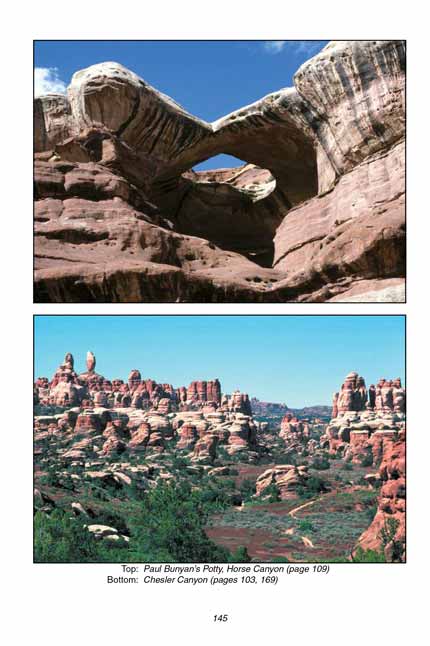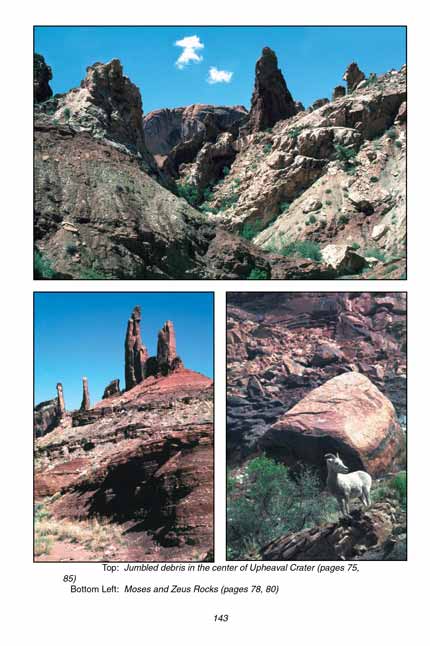Moses and Zeus Formations
excerpted from our book
Canyonlands National Park
Favorite Jeep Roads & Hiking Trails
pages 79-81
|
Buy book directly from the author!
Canyonlands National Park
Favorite Jeep Roads & Hiking Trails
- has access info for 75 trailheads
- 56 detailed trail maps
- 241 photographs
- loads of driving and hiking tips
|
regularly $14.95
now on sale for only
$11.95
click here
for book orders
|



 The landscape at the end of the Taylor Canyon Road is dominated by
Moses and Zeus, four slender spires of sandstone that beg to be investigated. The tallest
pinnacle rises 410 feet from its base, or 930 above the end of the road, and with a little imagination it is easy to see why the spire was named Moses.
It really does look like an old man wearing a long robe slightly hunched over as he gazes down upon the smaller figure, Zeus, in front of him. It is
not clear why Moses would be talking to Zeus, but his posture is very solemn and reverent, as if he were about to utter something of great importance.
The landscape at the end of the Taylor Canyon Road is dominated by
Moses and Zeus, four slender spires of sandstone that beg to be investigated. The tallest
pinnacle rises 410 feet from its base, or 930 above the end of the road, and with a little imagination it is easy to see why the spire was named Moses.
It really does look like an old man wearing a long robe slightly hunched over as he gazes down upon the smaller figure, Zeus, in front of him. It is
not clear why Moses would be talking to Zeus, but his posture is very solemn and reverent, as if he were about to utter something of great importance.
Like most of the pinnacles in Canyonlands, the
Moses and Zeus landmarks have been carved from the Wingate Formation, a hard, thick layer of dense ruddy sandstone
that for some reason tends to fracture along vertical planes. Moses and
Zeus are the eroded remains of a long point of land that once protruded from the south
side of Horsethief Mesa.
When I first saw this trail I wondered if the hike would really be worthwhile. From the road the Moses and Zeus formations looked impressive; however
I couldn’t see what would be gained by making the 500-foot climb up to the base of the rocks. But I was not disappointed. The hike turned out to be
much more interesting than anticipated.
From the Alcove Springs Trailhead the path proceeds southward for 150 yards to a junction where a sign marks the beginning of the Moses
and Zeus trail. Then,
soon after leaving the Alcove Springs Trail, the path starts its assent up the Moenkopi and Chinle Formations to the base of the Wingate Sandstone.
The route meanders a great deal to get around the shale ledges and outcroppings in the Moenkopi, so there are occasional stretches of level ground
and the climb is really not that tiring. There is one particularly interesting place where the trail crosses a 20-foot-long, windswept ridge of
bentonite, just before the final climb to the base of Zeus.
 After reaching the bottom of the monoliths the Moses and
Zeus trail splits, giving you the option of circling them in either direction. I recommend
you turn right here and go first along the southern side. The trail becomes ague and sometimes confusing, but the route is clear. Just traverse along
the base of the huge spires for a distance of about 0.2 mile until you reach the eastern side of Moses. Between Moses and the next chimney-shaped spire,
called Aphrodite, the trail drops into a saddle that allows you to access the north side of the
Moses and Zeus formation so you can complete the loop.
After reaching the bottom of the monoliths the Moses and
Zeus trail splits, giving you the option of circling them in either direction. I recommend
you turn right here and go first along the southern side. The trail becomes ague and sometimes confusing, but the route is clear. Just traverse along
the base of the huge spires for a distance of about 0.2 mile until you reach the eastern side of Moses. Between Moses and the next chimney-shaped spire,
called Aphrodite, the trail drops into a saddle that allows you to access the north side of the
Moses and Zeus formation so you can complete the loop.
Soon after you start west along the shady north side of the pinnacles you may spot a few cairns on your left. These cairns mark another spur trail
that climbs 60 feet to a narrow bench higher up the side of Moses. The bench ends at the top of a cliff on the extreme eastern end of Moses, about
80 feet above the pass. What a spectacular place to eat your lunch and contemplate the scene. The view from the end of this flat sandstone bench
includes a 360-degree panorama of the North and South Forks of Taylor Canyon, with Aphrodite (the Greek goddess of love and beauty) in front of you
and Moses (looking the other way!) behind you.
The walk back to the western side of Zeus is quite straightforward, and from there you can retrace your footsteps back to the
Moses and Zeus trailhead.
Note to web developers: You may copy this material onto your site, but in return please include a link to my home page
www.utahtrails.com. Thank you, David Day (utahdavidday at gmail.com)
Click here to see more trails in
Canyonlands National Park
© Rincon Publishing Company, all rights reserved
|



 The landscape at the end of the Taylor Canyon Road is dominated by
Moses and Zeus, four slender spires of sandstone that beg to be investigated. The tallest
pinnacle rises 410 feet from its base, or 930 above the end of the road, and with a little imagination it is easy to see why the spire was named Moses.
It really does look like an old man wearing a long robe slightly hunched over as he gazes down upon the smaller figure, Zeus, in front of him. It is
not clear why Moses would be talking to Zeus, but his posture is very solemn and reverent, as if he were about to utter something of great importance.
The landscape at the end of the Taylor Canyon Road is dominated by
Moses and Zeus, four slender spires of sandstone that beg to be investigated. The tallest
pinnacle rises 410 feet from its base, or 930 above the end of the road, and with a little imagination it is easy to see why the spire was named Moses.
It really does look like an old man wearing a long robe slightly hunched over as he gazes down upon the smaller figure, Zeus, in front of him. It is
not clear why Moses would be talking to Zeus, but his posture is very solemn and reverent, as if he were about to utter something of great importance.
 After reaching the bottom of the monoliths the Moses and
Zeus trail splits, giving you the option of circling them in either direction. I recommend
you turn right here and go first along the southern side. The trail becomes ague and sometimes confusing, but the route is clear. Just traverse along
the base of the huge spires for a distance of about 0.2 mile until you reach the eastern side of Moses. Between Moses and the next chimney-shaped spire,
called Aphrodite, the trail drops into a saddle that allows you to access the north side of the
Moses and Zeus formation so you can complete the loop.
After reaching the bottom of the monoliths the Moses and
Zeus trail splits, giving you the option of circling them in either direction. I recommend
you turn right here and go first along the southern side. The trail becomes ague and sometimes confusing, but the route is clear. Just traverse along
the base of the huge spires for a distance of about 0.2 mile until you reach the eastern side of Moses. Between Moses and the next chimney-shaped spire,
called Aphrodite, the trail drops into a saddle that allows you to access the north side of the
Moses and Zeus formation so you can complete the loop.